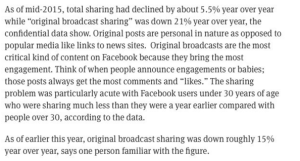POLITICAL HEAT BRINGS VIEWS TO THE HILL
For the coming round of political books, take note of this stat from AdWeek: “The election cycle is already paying off for The Hill. According to comScore’s December 2015 numbers, the politics site garnered nearly 10.6 million visitors, a 175 percent year-over-year increase.”
#politics
BRINGING ADS TO MESSAGING
It’s one of the continuing questions: as mobile messaging grows by leaps and bounds (even putting the fear of god into Facebook), how will advertisers reach users on these new platforms in a compelling way that’s authentic to the experience. Kik continues to innovate in this direction.
#messaging #adtech
A WORD BUSINESS IN AN IMAGE-FIRST WORLD
AdWeek looks at Merriam-Webster’s experiments with the new visual-first social network Peach. Will this one stick, or go the way of Ello? Either way, this is an interesting read for all of us in the word business.
#social #visual #peach
MOBILE APPS VS. MOBILE BROWSER
According to Dec 2015 research cited by eMarketer, mobile users are as likely to prefer using a mobile app as a mobile browser. In the “app versus browser” debate, one conclusion remains: That depends.
#mobile #apps #browsers #targeting
CJR DOES A DEEP-DIVE INTO RADIO’S REINVENTION
In an article that focuses on WNYC, Columbia Journalism Review looks into the ways that radio brands are trying to avoid the pitfalls that print journalism has fallen into by vigorously working to reinvent themselves for digital transformation. It’s a hopeful story.
#radio #podcasts #journalism
SNAPCHAT KEEPS UP THE PRESSURE
Snapchat enters 2016 just as they left 2015: talking about new ad products, better targeting, more opportunities.
#snapchat #social #targeting
PERISCOPE NOW AUTOPLAYING IN TWITTER APP
This is good news for getting your Periscope campaigns discovered in realtime.
#periscope #twitter #streaming
THE CASE FOR PRINT ADVERTISING
The continuing case for print advertising: it’s an oldie but a goodie, especially for book publishers: “The Ten Advantages of Advertising Books in Print Media” from Book Business magazine (via Digital Book World)
#print
PINTEREST: THUMBS UP OR DOWN?
A long-read from Business Insider about the prospects of Pinterest: ranging from what they’re doing right (audience engagement) to what they’re doing wrong (sales, basically). Mid-way through is a fact that should make publishers of Etsy-friendly books (lifestyle, crafting, food) pay attention, “It drives nearly as much traffic to the online marketplace Etsy as Facebook does.”
#pinterest #lifestyle
WHAT THE SUCCESS OF NATIVE ADVERTISING SAYS ABOUT CONTEXT
Digiday has a story about the success Time Out is seeing with their native ads. Implicit throughout is the importance of context for advertising. In the rush to programmatic targeting, context has been sold short the last few years. With the rise of native options, context is back.
#native #contextual
“LEGACY” NEWS IS CATCHING UP TO THE FUTURE
Conde Nast, Heart, The New York Times, The Washington Post and more “legacy” brands are getting their digital growth up to the speed of digital specialists like BuzzFeed. How? Bloomberg Media global head of digital, M. Scott Havens, says,
“If you’re doing what the startups are doing and you have the brand equity and resources to build and hire, I’m not shocked at all how well some of the older guys are doing.”
#legacy #digital
2016 DISPLAY AD SPENDING TO EXCEED SEARCH
The first truly successful ad model on the Web was search, but as people increasingly turn toward mobile, display ad spending is beginning to catch up.
#display #search #adspending






